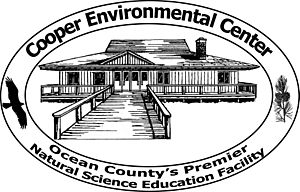Cattus Island Park facts for kids
Quick facts for kids Cooper Environmental Center |
|
|---|---|
 |
|
| Location | 1170 Cattus Island Blvd. Toms River, New Jersey, USA |
| Area | 530 acres (210 ha) |
Cattus Island Park, also known as Cattus Island, is a large park in Toms River, New Jersey. It covers about 530 acres (2 km2) of land. This park is a great place for quiet outdoor activities. It is managed by the Ocean County Department of Parks and Recreation. Cattus Island is also home to the Cooper Environmental Center. This center teaches visitors about local wildlife. It has collections of snakes, reptiles, and aquatic animals. The center also offers fun educational programs and presentations.
Contents
History of Cattus Island Park
Early Days and First Owners
The first European to explore this area was Captain Cornelius Hendrickson in 1615. He sailed along the New Jersey coast. He found Cattus Island, which was about 300 acres (1 km2) then. Later, in 1690, a man named William Dockwra bought Cattus Island. The land has stayed as one piece since that time.
In 1758, Joseph Page bought Cattus Island. His family settled there in 1763. They used the island for farming. They raised sheep and grew crops like flax and corn.
The American Revolution
During the American Revolutionary War, Cattus Island played a small but important role. Local people used the area to bring captured British ships into the Toms River. They would then unload the goods from these ships. Timothy Page, who was born on the island in 1763, fought in the local militia. He might have been a privateer. A privateer was like a pirate, but they had permission from the government to attack enemy ships. British ships were sometimes tricked into sailing into Barnegat Bay. Once there, they were attacked, and their cargo was sold for money. This happened through Cranberry Inlet, an opening to the Atlantic Ocean that existed from 1750 to 1812.
New Owners and Changes
After Timothy Page passed away, the family house burned down. The land was then sold to Lewis Applegate in 1842. He built a sawmill and a port for lumber boats on the southeastern part of the island. This area is still named after him. In 1867, the island was sold again. There were plans to build a resort, but a financial crisis in 1873 stopped the project.
In 1895, John V. A. Cattus bought the land. He was a New York importer and an Olympic athlete. He used the island as a peaceful getaway. He loved hunting and fishing with his friends. He built a hunting lodge, a farm, and a boat dock. After Cattus died, his sons sold the land in 1964 to developers.
Becoming a Park
In the 1970s, new state laws were passed to protect wetlands and coastal areas. Because of these laws, it became harder to build on the island. In 1973, Ocean County bought the land, which was about 497 acres (2 km2). They used county tax money and state "Green Acres" funds to buy it. In 1980, Cattus Island Park opened to the public. It also became home to the county's first Environmental Center.
Hurricane Sandy's Impact
In 2012, Hurricane Sandy caused a lot of damage to the park. Thousands of hours were spent clearing fallen trees and debris. In the years that followed, local Boy Scouts helped clean up the park. They also built new sections of boardwalk and benches for visitors. These projects helped them earn their Eagle Scout rank.
Park Ecosystems
Cattus Island Park is home to several different natural areas, called ecosystems. Each ecosystem has its own special plants and animals.
Maritime Upland Forest
One type of ecosystem in the park is a maritime upland forest. This forest is mostly made up of oak trees and pine trees. You can find trees like the pitch pine and the shortleaf pine here. Even though it's a maritime forest, you can also find many of the same shrubs and animals that live in the Pine Barrens.
Freshwater Wetlands
The park also has freshwater wetlands. These wet areas are filled with hardwood trees. Some common trees include Red Maple, also known as Swamp Maple, and Black Gum. There are also small groups of living Atlantic White Cedar trees in some wetland areas.
However, you can also see many dead Atlantic white cedar trees standing in the park. They have been dead since the 1930s. Before the 1930s, the northern part of Barnegat Bay, where Cattus Island is located, was mostly freshwater. But after the Point Pleasant Canal was built and the Manasquan Inlet was made better, saltwater from the ocean flowed into the bay. Atlantic white cedars need freshwater to live, so the saltwater killed them.
Salt Marsh
Another important ecosystem in the park is a large salt marsh. This marsh is full of different kinds of Spartina grasses. The salt marsh is actually why Cattus Island gets part of its name. Several times a year, the marshes flood. This can happen because of melting snow, heavy storms, or very high tides. When the marshes flood, some parts of the park become completely surrounded by water. This makes them seem like an 'island'.
Cooper Environmental Center
The Cooper Environmental Center is a special place for learning about nature. It helps teach people about protecting our environment. The building is about 5,000 square foot[convert: unknown unit] in size. It has a meeting room that can hold eighty people. There is also an interactive exhibit area where you can learn by doing. You can also see live native reptiles and fish on display.




